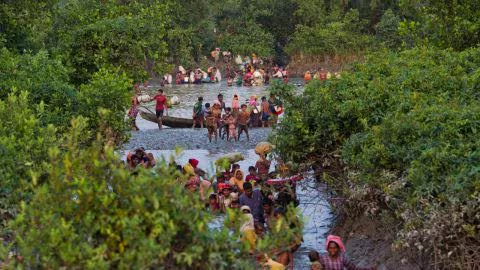Rohingya Caught in the Crossfire of Myanmar’s Civil War
In the escalating conflict in Myanmar’s Rakhine State, the Rohingya ethnic minority continues to suffer amid the ongoing civil war between the ruling military junta and various ethnic rebel groups. Recent reports have emerged of a devastating attack on August 5, 2024, where up to 200 civilians, including women and children, were reportedly killed in an artillery and drone strike. The incident occurred near the Naf River, close to the Bangladesh border, in an area primarily inhabited by the Muslim Rohingya.
Humanitarian Crisis Worsens
The violence in Rakhine State has intensified in recent months, with the townships of Maungdaw and Buthidaung becoming focal points of the conflict. The majority of the population in these areas is Rohingya, but Buddhist Rakhine communities also reside there. Eyewitness accounts suggest that the attack was carried out by the Arakan Army (AA), a significant force resisting Myanmar’s military rule. However, the AA has denied responsibility, instead blaming the Myanmar military and certain Rohingya militias for the violence.
The humanitarian situation in the region has deteriorated rapidly. Doctors Without Borders reported treating an unusually high number of Rohingya with war-related injuries who fled to Bangladesh following the attack. The blockade of aid deliveries and forced recruitment by various armed groups has further exacerbated the crisis. Many Rohingya are now living in dire conditions, struggling to find food and shelter.
The Complex Web of Conflict
The conflict in Rakhine is deeply complex, involving multiple ethnic groups and factions. The Arakan Army, which represents the Buddhist Rakhine people, has been fighting for greater autonomy in the region. Despite their claims of wanting to include the Rohingya in an autonomous Rakhine State, tensions between the two groups remain high.
On the other side, the Myanmar military, or the State Administrative Council (SAC), has been accused of exploiting these ethnic divisions to maintain control. Since the military coup in 2021, the SAC has used a “divide and rule” strategy, pitting different ethnic groups against each other to weaken opposition. This has included forcibly recruiting Rohingya into militias to fight against the Arakan Army, further deepening the conflict.
The Rohingya’s Plight
For the Rohingya, this conflict is yet another chapter in a long history of persecution. In 2017, around 750,000 Rohingya were forcibly expelled to Bangladesh by the Myanmar military in what the United Nations described as a “textbook example of ethnic cleansing.” Now, those who remain in Rakhine are caught between the front lines of a brutal civil war.
Despite the violence and mistrust, some analysts believe that peace between the Rakhine and Rohingya is still possible. They point to areas under Arakan Army control where both communities live relatively peacefully. However, as the conflict continues, the road to reconciliation remains fraught with challenges.
As Myanmar’s civil war drags on, the international community watches with growing concern, hoping for an end to the violence that has caused so much suffering for the Rohingya and other communities in the region.

